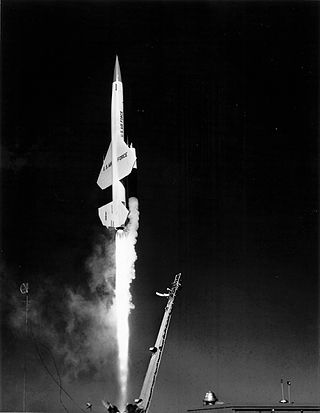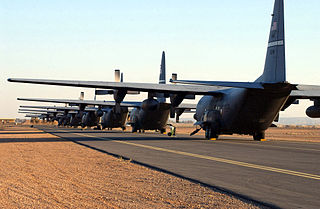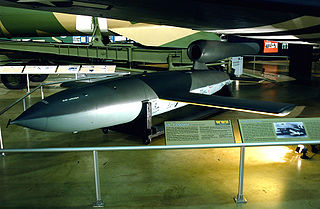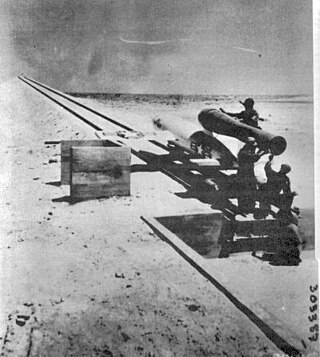
The Boeing CIM-10 Bomarc was a supersonic ramjet powered long-range surface-to-air missile (SAM) used during the Cold War for the air defense of North America. In addition to being the first operational long-range SAM and the first operational pulse doppler aviation radar, it was the only SAM deployed by the United States Air Force.

Rome Laboratory is a U.S. Air Force research laboratory for "command, control, and communications" research and development and is responsible for planning and executing the USAF science and technology program.

The Martin MGM-1 Matador was the first operational surface-to-surface cruise missile designed and built by the United States. It was developed after World War II, drawing upon their wartime experience with creating the Republic-Ford JB-2, a copy of the German V-1. The Matador was similar in concept to the V-1, but it included a radio command that allowed in-flight course corrections. This allowed accuracy to be maintained over greatly extended ranges of just under 1000 km. To allow these ranges, the Matador was powered by a small turbojet engine in place of the V-1's much less efficient pulsejet.

The Air Force Missile Development Center and its predecessors were Cold War units that conducted and supported numerous missile tests using facilities at Holloman Air Force Base, where the center was the host unit.

The Martin Mace was a ground-launched cruise missile developed from the earlier Martin TM-61 Matador. It used a new self-contained navigation system that eliminated the need to get updates from ground-based radio stations, and thereby allowed it to fly further beyond the front lines. To take advantage of this longer practical range, Mace was larger than Matador and could travel a longer total distance.
Ground-directed bombing (GDB) is a military tactic for airstrikes by ground-attack aircraft, strategic bombers, and other equipped air vehicles under command guidance from aviation ground support equipment and/or ground personnel. Often used in poor weather and at night, the tactic was superseded by an airborne computer predicting unguided bomb impact from data provided by precision avionics Equipment for radar GDB generally included a combination ground radar/computer/communication system and aircraft avionics for processing radioed commands.

The 486th Air Expeditionary Wing is a provisional United States Air Force unit assigned to the Air Combat Command. As a provisional unit, it may be activated or inactivated at any time.

The 485th Air Expeditionary Wing is a provisional United States Air Force unit assigned to Air Combat Command. As a provisional unit, the 485 AEW may be inactivated or activated at any time by Air Combat Command. The wing was last known to be active during Operation Iraqi Freedom in 2003 at Tabuk Regional Airport, Saudi Arabia, in 2003.

The Republic-Ford JB-2, also known as the Thunderbug, KGW and LTV-N-2 Loon, was a United States copy of the German V-1 flying bomb. Developed in 1944, and planned to be used in the United States invasion of Japan, the JB-2 was never used in combat. It was the most successful of the United States Army Air Forces Jet Bomb (JB) projects during World War II. Postwar, the JB-2 played a significant role in the development of more advanced surface-to-surface tactical missile systems such as the MGM-1 Matador and later MGM-13 Mace.

The 868th Tactical Missile Training Squadron is an inactive unit of the United States Air Force. Its last assignment was with the 868th Tactical Missile Training Group, at Davis Monthan Air Force Base, Arizona, where it conducted training with the BGM-109G Gryphon. It was inactivated on 31 May 1990.

The 30th Tactical Missile Squadron is an inactive United States Air Force unit. In 1985 the squadron was formed by combining three United States Air Force and Army Air Forces units that had served in World War II and the Cold War into a single unit with a common heritage. However, the combined unit has not since been active.

The 1st Tactical Missile Squadron is an inactive United States Air Force unit. It was last assigned to the 585th Tactical Missile Group at Bitburg Air Base, West Germany, where it was inactivated on 18 June 1958.

The 1st Experimental Guided Missiles Group is an inactive United States Air Force unit. It was last assigned to the Air Proving Ground Command and stationed at Eglin Air Force Base, Florida. It was inactivated on 22 July 1949.

The 4504th Missile Training Wing is an inactive United States Air Force unit. It was last assigned to Ninth Air Force, Tactical Air Command, stationed at Orlando Air Force Base, Florida. It was inactivated on 25 March 1967.

The Reeves AN/MSQ-77 Bomb Directing Central, Radar was a United States Air Force automatic tracking radar/computer system for command guidance of aircraft. It was often used during Vietnam War bomb runs at nighttime and during bad weather. Developed from the Reeves AN/MSQ-35, the AN/MSQ-77 reversed the process of Radar Bomb Scoring by continually estimating the bomb impact point before bomb release with a vacuum tube ballistic computer. Unlike "Course Directing Centrals" which guided aircraft to a predetermined release point, the AN/MSQ-77 algorithm continuously predicted bomb impact points during the radar track while the AN/MSQ-77's control commands adjusted the aircraft course. A close air support regulation prohibited AN/MSQ-77 Combat Skyspot bombing within 1,000 yd (910 m) of friendly forces unless authorized by a Forward Air Controller, and "on several occasions" strikes were as close as 273 yd (250 m).
Radar Bomb Scoring is a combat aviation ground support operation used to evaluate Cold War aircrews' effectiveness with simulated unguided bomb drops near radar stations of the United States Navy, the USAF Strategic Air Command, and Army Project Nike units. USAF RBS used various ground radar, computers, and other electronic equipment such as jammers to disrupt operations of the bomber's radar navigator, AAA/SAM simulators to require countermeasures from the bomber, and Radar Bomb Scoring Centrals for estimating accuracy of simulated bombings. Scores for accuracy and electronic warfare effectiveness were transmitted from radar sites such as those at Strategic Range Training Complexes.
Combat Skyspot was the ground-directed bombing (GDB) operation of the Vietnam War by the United States Air Force using Bomb Directing Centrals and by the United States Marine Corps using Course Directing Centrals. Combat Skyspot's command guidance of B-52s and tactical fighters and bombers—"chiefly flown by F-100's"—at night and poor weather was used for aerial bombing of strategic, close air support, interdiction, and other targets. Using a combination radar/computer/communications system at operating location in Southeast Asia, a typical bombing mission had an air command post turn over control of the mission to the radar station, and the station provided bomb run corrections and designated when to release bombs.
The AN/MPQ-2 Close Cooperation Control Unit was a truck-mounted pautomatic tracking radar/computer/communication system for aircraft command guidance, e.g., missile tracking, and for Radar Bomb Scoring. It was introduced shortly after the end of World War II. For ground directed bombing (GDB), an operator would manually plot a target on the "Blind Bombing Plotting Sheet", then use the manual "E6B computer and bombing tables" to plot the release point for striking the target, after which a radar operator used the AN/MPQ-2 to acquire a track of the bomber near an initial point during which allowed ground control of the bomb run to the release point.
The Reeves AN/MSQ-1 Close Support Control Set produced by Reeves Instrument Corporation was a trailer-mounted combination radar/computer/communication developed under a Rome Air Development Center program office for Cold War command guidance of manned aircraft Developed for Korean War ground-directed bombing, one detachment of the 3903rd Radar Bomb Scoring Squadron bombed itself with an MSQ-1 because it mistakenly used procedures for the earlier SCR-584/OA-294 system The MSQ-1 was subsequently used for nuclear testing during Operation Teapot, and for aircraft tests such as for "MSQ-1 controlled pinpoint photography" in 1954.
Genesee Mountain Park Training Annex (1955–70) was a U.S. Air Force radar station, an outstation of Lowry Air Force Base. It is a Formerly Used Defense Site of 3 acres (1.2 ha) at Genesee Park (Colorado)













